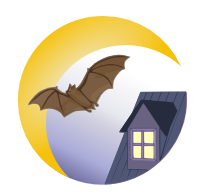If there is a bat in your house and you have not come into contact with it
In summer
- Restrict the bat to a single room by closing the door(s) to the room that it is in
- Open the windows, remove the screens, and turn off the lights
- Leave the room, closing the door behind you. In most cases, the bat will leave out the window on its own. If it does not leave, wait for it to settle down
-
If the bat does not leave, wait for it to settle down, and then capture it using the protocol described below. After capturing the bat, it should be in a container inside a box. If the bat is obviously injured, take it to a nearby wildlife rehabilitation center (click here for a list of centers)
- If no people or pets have come into contact with the bat, you can release it outside. Open the container and put the box on its side at the base of a tree. The bat will be able to climb up the tree and fly away.
-
Check on the bat approximately 24 hours later. It is important that you wait at least 24 hours to check on the bat because bats are able to drop their body temperatures into a state called torpor where the bat may appear dead. In order to not confuse a torpid bat from a dead bat, allow the bat at least 24 hours to leave the box. If the bat is still alive, but it still has not moved, take it to a nearby wildlife rehabilitation center (click here for a list of centers)
- If the bat has died, contact the appropriate agency where you should report dead bats (see below).
In winter If you find an active bat during the winter, it is because it has woken up from hibernation. It requires a lot of energy for a bat to awake from hibernation; therefore, they are very sensitive at this point in time.
Try to capture the bat using the method described above. Check if people or pets who live in the house may have come into contact with the bat. a) Possible contact with: Person (s) or child (ren) in the same room: Please contact the health line associated with your province or territory, or a doctor as mentioned in the previous section “If you come onto contact with a bat”. For pets, please contact your veterinarian. b) No contact: Click here to find a Wildlife Rehabilitation Centre near to you. People in charge of the refuge will organize the transport of the bat with you. For injured bats or in the absence of a nearby refuge, you must contact the nearest wildlife protection office to inform them as mentioned below.
Be careful - if you come into contact with a bat
A wound inflicted by a bat can go unnoticed but should be taken seriously due to the small risk of contracting rabies. Anyone who has touched or been touched by a bat should:
- Immediately wash the exposed skin with soap and water for 15 minutes
- Contact the health line associated with your province or territory, or a doctor to evaluate whether or not you should receive the rabies vaccination:
- Quebec: Info-Santé - 8-1-1
- Ontario: TeleHealth - 1-866-797-0000
- Manitoba: Health Links - 1-888-315-9257
- Saskatchewan: Health Links - 8-1-1
- Alberta: Health Links - 8-1-1 (or 1-866-408-5465)
- If possible, safely capture the bat (see steps below). The health care professional will be able to guide you where you need to take the bat to have it analyzed
- If your pet has come into contact with a bat or ended up in the same room without supervision, you should contact your veterinarian.
If you find an injured, dying or dead bat
- Try to capture the bat using the method described above
- Next, place the box in a dark, quiet place
- Across Canada, all dead or sick bats should be reported
- Ontario: Contact the Canadian Wildlife Health Cooperative (CWHC) at 1-866-673-4781 or Natural Resources Information Centre at 1-800-667-1940
- Manitoba: Contact the Canadian Wildlife Health Cooperative (CWHC) at 306-966-4815
- Saskatchewan: Contact the Canadian Wildlife Health Cooperative (CWHC) at 306-966-4815
- Alberta: Contact Alberta Environment and Parks, Fish & Wildlife Office – 1-877-944-0313 (or visit http://aep.alberta.ca/about-us/contact-us/fish-and-wildlife-area-office…)
- Quebec: Contact the Ministère de l'Environnement, de la Lutte contre les changements climatiques, de la Faune et des Parcs (MELCCFP) at 1-877-346-6763
- Yukon: Conservation officer (TIPP line) at 1-800-661-0525
- For advice on what to do with and sick or injured bat, please contact your local rehabilitation centre after reporting the bat as directed above.
- Ontario: http://www.ontariowildliferescue.ca/wildlifecentres/?care=bat.
- Manitoba: Wildlife Haven Rehabilitation Centre at 204-878-3740
- Alberta: www.albertabats.ca/foundabat
- Saskatchewan: batwatchsk@gmail.com
- Quebec: Ministère de l'Environnement, de la Lutte contre les changements climatiques, de la Faune et des Parcs (MELCCFP) at 1-877-346-6763
- Yukon: Conservation officer (TIPP line) at 1-800-661-0525
How to capture a bat
- Wear thick gloves whenever you are trying to capture a bat
- Capture the bat under a solid container (e.g. yogurt container), then, slide a lid onto the container by lifting the container slightly off the surface.
- Make sure air can get into the container, then place it in a box in an area where it is dark and quiet.
- Disinfect your gloves
- Wash your hand with warm water and soap
- Depending on the circumstances, follow the instructions above regarding who you should contact.
Preventing bats from entering your house
- Try to find the opening where the bat entered the house
- Either caulk or add a screen to the point(s) of entry
- Make sure you have functioning screens on all your doors and windows

